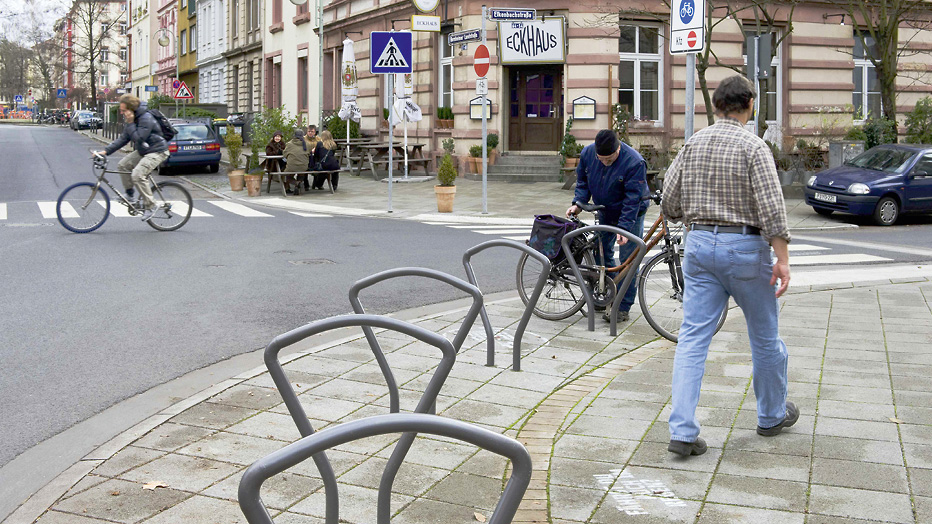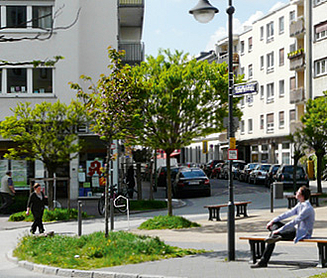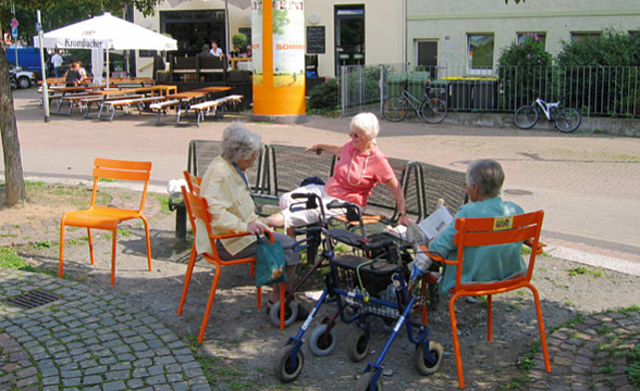Project Profile
Project Title: „Promoting short-range mobility“
Project Category: Mobility
Comprises the following projects and measures:
Pilot project „ Short-range mobility Nordend“, research project „Networked play and meeting spaces“, local planning - the neighbourhood car park at the former Glauburg School, updating Bicycle Traffic Concept
Project Participants: inter-departmental and interdisciplinary (Traffic, Urban and Open Space Planning)
Contact: Mobility and Traffic Planning Department
Encouraging sustainable urban forms of mobility, such as walking and cycling, means developing urban districts in which people like to live and where they can move about safely. The “city of short distances“ is the result of systematic promotion and a wide range of actions.
By creating good conditions for pedestrians and cyclists, cities not only promote environmentally- and climate-friendly forms of mobility, they also help restrict noise and pollutants. Promoting short-range mobility also contributes to more road safety, accident prevention while offering a good basis for children, elderly people and those with limited mobility to get about independently and safely. In other words, adjusting to demographic change is another aspect of short-range mobility.
The local economy in the urban districts benefits from excellent accessibility. Having a wide range of amenities at hand is an incentive to go shopping on foot or by bicycle. After all, it is the non-motorised road users who contribute to the urbanity and liveliness of the urban districts in which people enjoy living.
Frankfurt began its sponsorship of short-range mobility a long time ago. In 1992, Frankfurt‘s city parliament agreed on a “Bicycle Traffic Concept“, followed in 2005 by the Traffic Master Plan, an action plan to promote bicycle traffic which is being substantiated and implemented. Bicycle traffic among Frankfurt’s population has grown from 9.5 percent (2003) to 14.4 percent (2013) (inner-city routes).
Pilot project for short-range mobility: testing simple, effective measures
Based it on the overall traffic plan, in 2006 Frankfurt started the pilot project “Short-range Mobility Nordend“, which was to evaluate effective measures to improve conditions for pedestrians. This included widening the pavements into the junction areas of streets – the pavement noses – and the barrier-free, safe design of paths, adequate pavement widths, as well as changing traffic regulations and planting trees. In the follow-up research project “inter connected play and meeting areas “, numerous ideas were developed for bringing life to widely-used places and routes in the district, such as interaction zones in residential streets, benches along everyday routes, temporary play streets and “Public Bookcases“.
Experience gained in these projects is also transferred to other urban districts, for example, whenever possible, “pavement noses “ are built during road renovation: pavements on street corners are widened into the roadway making it easier and safer for pedestrians to cross. The junction is kept free of illegally parked cars and can be upgraded in terms of city planning. This makes room for seats, bicycle stands and trees.
Local planning: re-designing a district attractively
Suggestions from the public participation process were incorporated into the pilot project near the new garage at the former Glauburg School in Frankfurt Nordend, which re-designed street corners and pavements, inviting people to linger for a while and also making the pavements safer places. One row of parking spaces has been removed to make room for wider pavements, new benches and trees. Some parking bays were unsealed and allocated as a planting area for a residents' Urban-Gardening initiative.
Closing gaps: making bicycle routes functional in full length
The bicycle traffic concept of 1992 was last updated in 2014 and adjusted to current developments such as the large-scale urban development areas, Riedberg and Europaviertel.
The focal point of the most recent adjustment is making the cycle-path network functional in its full length. Gap-closing programmes remove shortcomings in the bicycle traffic management of certain sections and create links to existing network elements. The Reporting platform Bicycle traffic helps identify these gaps in the network.
Bicycle traffic signposting is to be city-wide. 2016 saw the start of the implementation in the West of Frankfurt.

City-compatible
Creating good conditions for pedestrians and cyclists; promoting environmentally- and climate-friendly forms of mobility; preventing noise and pollutants; closing gaps in the network.

Bustling
Promoting the urbanity and liveliness of urban districts; ensuring a wide variety of local amenities; creating play and meeting areas.





